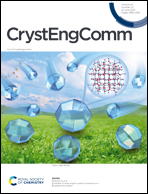Acyl amide-functionalized and water-stable iron-based MOF for rapid and selective dye removal†
Abstract
Multinuclear cluster-based metal–organic frameworks (MOFs) have shown excellent activity in toxic chemical removal from wastewater due to their high porosity, functionality and water stability. In this regard, a highly porous, water-stable Fe-MOF was fabricated and the efficiency of its acyl amide-functionalized pores for organic dye removal was investigated. Different anionic and cationic dyes including methyl orange (MO), methyl red (MR), congo red (CR), rose-bengal B (Ros B), rhodamine B (Rhod B) and methylene blue (MB) were applied to determine the Fe-MOF efficiency. The presence of acyl amide improves the host-guest interaction of the framework towards anionic dyes, specifically MO with an adsorption capacity of 232.5 mg g−1. Interestingly, the Fe-MOF shows one of the fastest adsorptions of MO with a kinetic constant of 0.013 g mg−1 min−1 which is faster than those of some of the well-known MOFs such as UiO-66, MOF-235, MIL-53, MIL-101, UiO-66-NO2 and ZIF-67. The adsorption mechanism, uptake kinetics and selectivity of the framework for different dyes were also studied. Overall, water stable Fe-MOF with a high permanent porosity as well as rational decoration of pores with specific functions, improved the size and charge selective dye removal by the preferred H-bonding and π–π interactions.



 Please wait while we load your content...
Please wait while we load your content...